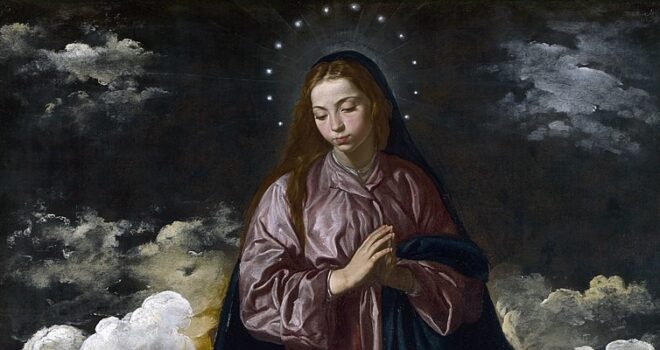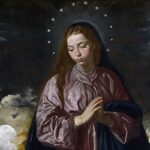Our Lady’s Savior: On the Immaculate Conception
Et exultavit spiritus meus in Deo Salutari meo…And my spirit rejoices in God my Savior. (Luke 1:47) Let us reflect in this second article of the Magnificat series on the words “My Savior”—on how the Blessed Virgin Mary is saved by Jesus, Her Son. And the word became flesh and dwelt among us. (John 1:14) […]



Et exultavit spiritus meus in Deo Salutari meo…And my spirit rejoices in God my Savior. (Luke 1:47)
Let us reflect in this second article of the Magnificat series on the words “My Savior”—on how the Blessed Virgin Mary is saved by Jesus, Her Son.
And the word became flesh and dwelt among us. (John 1:14)
When the angel Gabriel announces to the Blessed Virgin Mary that She is to be the Mother of God, and She says, “may it be done to me according to your word” (Luke 1:38), the Word, the Second Person of the Blessed Trinity becomes incarnate in Her womb. This event, the Incarnation, is the greatest event of all time. God becomes man.
But it would not be proper for the Thrice-Holy God to take on flesh, thus drawing His Humanity, from a Mother stained with the original sin of Adam and Eve, which all their offspring inherit. Venerable Pope Pius XII says:
It was fitting that Jesus Christ should have such a mother as would be worthy of Him as far as possible; and she would not have been worthy if, contaminated by the hereditary stain even from the first moment of her conception, she had been subject to the abominable power of Satan. (Fulgens Corona, n. 13)
Because of this, the Mother of God is saved by Her Son Jesus, the Savior of the entire human race, in an entirely unique and most sublime way, which befits Her dignity as the Mother of God. The Blessed Virgin Mary is conceived in the womb of Saint Ann by a conjugal act of Her parents Saint Joachim and Saint Ann, and from the first moment of Her conception She is preserved from all stain of original sin by virtue of the merits of Her Son, Jesus Christ.
God, who is not bound to the limitations of time, exercised His salvific grace upon Blessed Mary at the moment of Her conception. She did not have to wait temporally until Christ suffered, died, and descended to the dead the way that the rest of us did. She was saved in a special, anticipatory manner where she received the benefits of the salvation that Her Son would bring in the future. Thus, in this way, Our Lady is immaculately conceived.
On December 8, 1854, Blessed Pope Pius IX, in the presence of a great number of cardinals and bishops at Saint Peter’s Basilica in Rome, solemnly defined the Dogma of the Immaculate Conception:
We declare, pronounce, and define that the doctrine which holds that the most Blessed Virgin Mary, in the first instance of Her conception, by a singular grace and privilege granted by Almighty God, in view of the merits of Jesus Christ, the Savior of the human race, was preserved free from all stain of original sin, is a doctrine revealed by God and therefore to be believed firmly and constantly by all the faithful. (Apostolic Constitution Ineffabilis Deus, December 8, 1854; cf. Catechism of the Catholic Church, n. 491)
Four years later, on March 25, 1858, Saint Bernadette Soubirous, in the grotto of Massabielle, asked the Blessed Virgin Mary what Her name is, and She responded: “I am the Immaculate Conception.” Venerable Pope Pius XII says that Our Blessed Mother wished to confirm what Blessed Pope Pius IX “with infallible apostolic authority” defined “amidst the applause of the whole Church” (cf. Fulgens Corona, n. 1, 3), that is, the Dogma of the Immaculate Conception.
What is a dogma of the faith?
The Church’s Magisterium exercises the authority it holds from Christ to the fullest extent when it defines dogmas, that is, when it proposes truths contained in divine Revelation or having a necessary connection with them, in a form obliging the Christian people to an irrevocable adherence of faith…Dogmas are lights along the path of faith; they illuminate it and make it secure. (Catechism of the Catholic Church, n. 88, 89).
All Catholics then, are obliged, are bound, to adhere to the Dogma of the Immaculate Conception. We must believe it.
Inseparable from the fact that Our Blessed Mother was conceived without original sin is the fact that She never committed an actual sin either. Saint Thomas Aquinas says:
Now the Blessed Virgin was chosen by God to be His Mother. Therefore there can be no doubt that God, by His grace, made her worthy of that office…But she would not have been worthy to be the Mother of God if she had ever sinned…the Blessed Virgin committed no actual sin, neither mortal nor venial; so that what is written (Canticles 4:7) is fulfilled: “Thou art all fair, O my love, and there is not a spot in thee,” etc. (ST III, q. 27, a. 4)
God created a Mother worthy of Himself. The Second Person of the Trinity draws His Humanity entirely from Her; He is the Son of God and the Son of Mary. She is truly worthy to be the dwelling place of God, truly worthy to be the Mother of God; She is all holy, without spot, Immaculate. As Sacred Scripture says: “For she is a breath of the power of God, and a pure emanation of the glory of the Almighty” (Wisdom 7:25; cf. Catechism of the Catholic Church, n. 721). She is “full of grace” entirely by His grace.
Thus, in summary, “with a view to the saving death of the Son, Mary, his Mother was preserved free from original sin and from every other sin” (Pope Saint John Paul II, Homily on the 150th anniversary of the Dogma of the Immaculate Conception, Dec 8, 2004).
The Blessed Mother was redeemed by Jesus, Her Son, by His future merits in time in an entirely unique way; She was the first to be saved by Him. Therefore, He is truly Her Savior in Whom She rejoices as She says, “and my spirit rejoices in God my Savior” (Luke 1:47).
Velázquez, D. (1618). Inmaculada Concepción [painting]. Retrieved from Wikimedia Commons.














